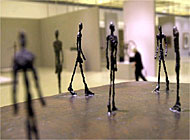Zurich art museum presents “the whole Giacometti”

The first major retrospective of works by Swiss artist Alberto Giacometti - regarded by many as the 20th century's leading sculptor - has opened in Zurich to mark the centenary of his birth.
Organised by the Zurich Kunsthaus in collaboration with the Alberto Giacometti Foundation and the Museum of Modern Art – MoMA in New York, it is the first exhibition to span every stage of the career of the artist, who died in 1966.
Never before have works from his earlier cubist and surrealist periods been seen alongside sculptures created by Giacometti after World War II, something that makes the exhibition special. Ninety sculptures, 40 paintings and 60 drawings are on show, some of which had not previously appeared in public.
“In the past, Giacometti exhibitions were hampered because of the fragility of the works from his avant-garde period,” Ann Umland of MoMA told swissinfo, “and it’s their presence that makes this one unique.”
The idea for a collaborative project came from the Kunsthaus, which proposed the idea to the MoMA, one of the world’s foremost art museums, over fours years ago. When it closes at the beginning of September, the exhibition will be transferred to MoMA for an October 10 opening – the date of Giacometti’s death.
Umland is enthusiastic about the prospect. “Every generation assesses artists anew,” she said, “and Giacometti’s works have not been seen in New York for over a generation. There are no doubts about his greatness…it’s constantly being re-evaluated and rethought. And new audiences will bring a new meaning to it.”
The deputy director of the Kunsthaus and one of the curators, Christian Klemm, said the exhibition’s aim is to present “the whole Giacometti”. He told swissinfo: “Giacometti was not just the most important surrealist sculptor, he was the only important one.”
Giacometti had a studio in Paris for most of his working life, but regularly went back to his home village of Stampa, near the Italian border in Canton Graubünden. Family roots were important to him – as were their artistic influence.
His father, Giovanni, was a respected painter, and family friends included the artists Cuno Amiet and Ferdinand Hodler.
During the 1930s, Giacometti’s Paris circle of friends included the philosopher Jean-Paul Sartre, Picasso and many other leading artists of the period.
His post-war years were devoted to traditional forms of sculpture, after periods as a follower of movements such as surrealism – which, as joint-curator Klemm says “he left because he saw himself as an important artist in the traditional sense.”
While the surrealist works have rarely been seen in public, others are more familiar.
For example the extremely thin and fragile walking figures he created are well known throughout the art world and beyond. One of them, “The Striding Man” is even featured on the SFr100 banknote.
by Richard Dawson

In compliance with the JTI standards
More: SWI swissinfo.ch certified by the Journalism Trust Initiative
You can find an overview of ongoing debates with our journalists here . Please join us!
If you want to start a conversation about a topic raised in this article or want to report factual errors, email us at english@swissinfo.ch.